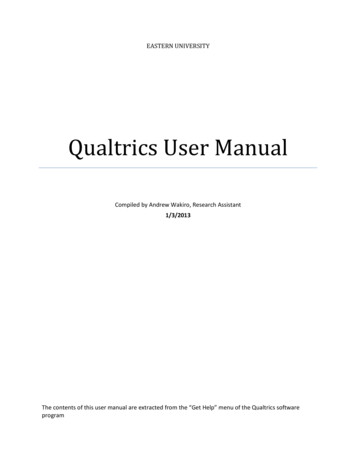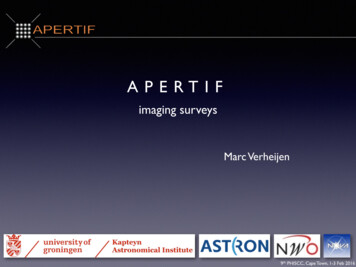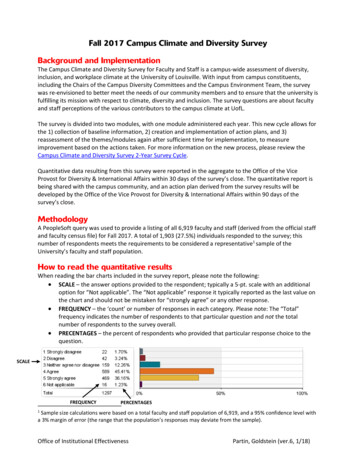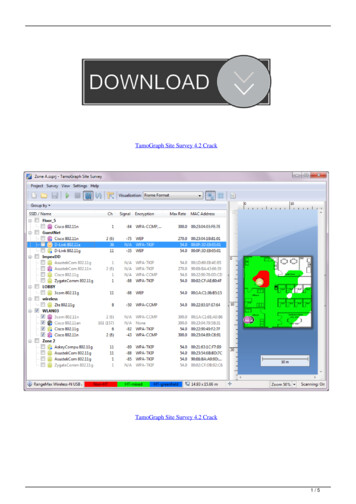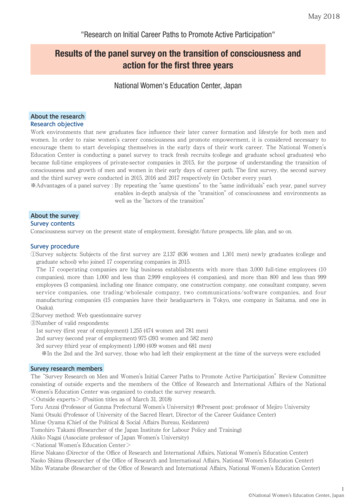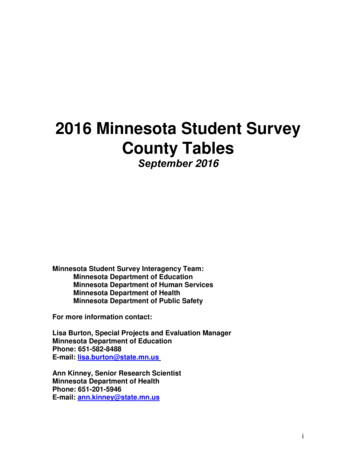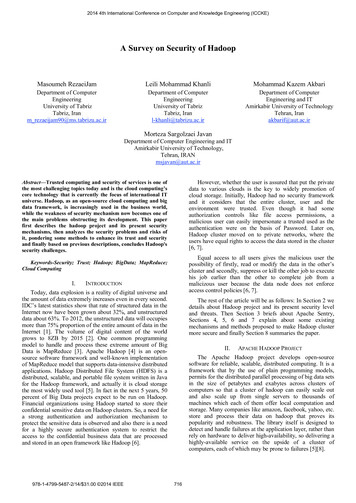
Transcription
WK ,QWHUQDWLRQDO &RQIHUHQFH RQ &RPSXWHU DQG .QRZOHGJH (QJLQHHULQJ ,&&.( A Survey on Security of HadoopMasoumeh RezaeiJamLeili Mohammad KhanliMohammad Kazem AkbariDepartment of ComputerEngineeringUniversity of TabrizTabriz, Iranm rezaeijam90@ms.tabrizu.ac.irDepartment of ComputerEngineeringUniversity of TabrizTabriz, Iranl-khanli@tabrizu.ac.irDepartment of ComputerEngineering and ITAmirkabir University of TechnologyTehran, Iranakbarif@aut.ac.irMorteza Sargolzaei JavanDepartment of Computer Engineering and ITAmirkabir University of Technology,Tehran, IRANmsjavan@aut.ac.irHowever, whether the user is assured that put the privatedata to various clouds is the key to widely promotion ofcloud storage. Initially, Hadoop had no security frameworkand it considers that the entire cluster, user and theenvironment were trusted. Even though it had someauthorization controls like file access permissions, amalicious user can easily impersonate a trusted used as theauthentication were on the basis of Password. Later on,Hadoop cluster moved on to private networks, where theusers have equal rights to access the data stored in the cluster[6, 7].Abstract—Trusted computing and security of services is one ofthe most challenging topics today and is the cloud computing’score technology that is currently the focus of international ITuniverse. Hadoop, as an open-source cloud computing and bigdata framework, is increasingly used in the business world,while the weakness of security mechanism now becomes one ofthe main problems obstructing its development. This paperfirst describes the hadoop project and its present securitymechanisms, then analyzes the security problems and risks ofit, pondering some methods to enhance its trust and securityand finally based on previous descriptions, concludes Hadoop'ssecurity challenges.Equal access to all users gives the malicious user thepossibility of firstly, read or modify the data in the other’scluster and secondly, suppress or kill the other job to executehis job earlier than the other to complete job from amalicizous user because the data node does not enforceaccess control policies [6, 7].Keywords-Security; Trust; Hadoop; BigData; MapReduce;Cloud ComputingI. INTRODUCTIONToday, data explosion is a reality of digital universe andthe amount of data extremely increases even in every second.IDC’s latest statistics show that rate of structured data in theInternet now have been grown about 32%, and unstructureddata about 63%. To 2012, the unstructured data will occupiesmore than 75% proportion of the entire amount of data in theInternet [1]. The volume of digital content of the worldgrows to 8ZB by 2015 [2]. One common programmingmodel to handle and process these extreme amount of BigData is MapReduce [3]. Apache Hadoop [4] is an opensource software framework and well-known implementationof MapReduce model that supports data-intensive distributedapplications. Hadoop Distributed File System (HDFS) is adistributed, scalable, and portable file system written in Javafor the Hadoop framework, and actually it is cloud storagethe most widely used tool [5]. In fact in the next 5 years, 50percent of Big Data projects expect to be run on Hadoop.Financial organizations using Hadoop started to store theirconfidential sensitive data on Hadoop clusters. So, a need fora strong authentication and authorization mechanism toprotect the sensitive data is observed and also there is a needfor a highly secure authentication system to restrict theaccess to the confidential business data that are processedand stored in an open framework like Hadoop [6]. ,(((The rest of the article will be as follows: In Section 2 wedetails about Hadoop project and its present security leveland threats. Then Section 3 briefs about Apache Sentry,Sections 4, 5, 6 and 7 explain about some existingmechanisms and methods proposed to make Hadoop clustermore secure and finally Section 8 summaries the paper.II. APACHE HADOOP PROJECTThe Apache Hadoop project develops open-sourcesoftware for reliable, scalable, distributed computing. It is aframework that by the use of plain programming models,permits for the distributed parallel processing of big data setsin the size of petabytes and exabytes across clusters ofcomputers so that a cluster of hadoop can easily scale outand also scale up from single servers to thousands ofmachines which each of them offer local computation andstorage. Many companies like amazon, facebook, yahoo, etc.store and process their data on hadoop that proves itspopularity and robustness. The library itself is designed todetect and handle failures at the application layer, rather thanrely on hardware to deliver high-availability, so delivering ahighly-available service on the upside of a cluster ofcomputers, each of which may be prone to failures [5][8].
However, enterprises wants to protect sensitive data,while the weakness of security mechanism now becomes oneof the main problems obstructing hadoop’s development anduse [9] and because of the lack of a valid user authenticationand data security defense measures, Hadoop is now facingmany security problems in the data storage [3].2. Authentication : Kerberos3. Authorization : e.g. HDFS permissions, HDFSACL3s, MR ACLs4. OS Security and data protection : encryption ofdata in network and HDFSx Centralized authentication, authorization andaudit for Hadoop REST/HTTP servicesx LDAP 4 /AD 5 Authentication,Authorization and Auditx Kerberosx LDAP, ActiveDirectoryx LDAP, AD integrated withestablishing a single point of truthx Single point of truthKerberos,In the development of HDFS cluster, it places the trustedserver authentication key in each node of the cluster toachieve the reliability of the Hadoop cluster nodecommunication, which can effectively prevent non-trustedmachines posing as internal nodes registered to theNameNode and then process data on HDFS. This mechanismis used throughout the cluster. So from storage perspective,Kerberos can guarantee the credibility of the nodes in HDFScluster [3].Kerberos can be connected to corporate LDAPenvironments to centrally provision user information.Hadoop also provides perimeter authentication throughApache Knox for REST APIs and Web services [16].1) Apache Knox GatewayThe Apache Knox Gateway [14] is a system thatprovides a single point of authentication and access forApache Hadoop services. It accesses over HTTP/HTTPs toHadoop Cluster and provides the following features [12]:Single REST API Access PointHides Network Topology.Kerberos is a computer network authentication protocolwhich works on the basis of “tickets” to allow nodescommunicating over a non-secure network to prove theiridentity to one another in a secure manner [3].Now we provide description for these layers asfollow.x x For strong authentication, Hadoop uses [15]Layers of defense for a hadoop cluster are [12, 13]Perimeter Level Security : Network Securityfirewalls, Apache Knox gatewayEliminates SSH edge node risks2) AuthenticationAuthentication means to identify who you are. Providerswith the role of authentication are responsible for collectingcredentials presented by the API consumer, validating themand communicating the successful or failed authentication tothe client or the rest of the provider chain [14]. By thisprimer security, untrusted users do not have access to thecluster network and trusted network, everyone is goodcitizen. Your identity is determined by client host.A. Present Hadoop Security LevelHadoop default means consider network as trusted andhadoop client uses local username. In default method, thereis no encryption between hadoop and client host [10] and inHDFS, all files are stored in clear text and controlled by acentral server called NameNode. So, HDFS has no securityappliance against storage servers that may peep at datacontent. Additionally, Hadoop and HDFS have no strongsecurity model, in particular the communication betweendatanodes and between clients and datanodes is notencrypted [11]. To solve these problems, some mechanismshave been added to Hadoop to maintain them. For instance,by strong authentication, hadoop is secured with Kerberosand thorough it, provides mutual authentication and protectsagainst eavesdropping and replay attacks. Every user andservice has a Kerberos “principal” and credentials are byService: keytab 1 s and User: password which RPC 2Encryption should be enabled [10].1. x Hadoop relies completely on Kerberos for authenticationbetween the client and the server. Hadoop 1.0.0 versioncomes with the Kerberos mechanism. An encrypted tokenthe authentication agent will be requested by the client.Using this, he can request for a particular service from theserver [3, 6].However, Kerberos is ineffective against Passwordguessing attacks and does not provide multipartauthentication [6].Service3) AuthorizationAuthorization or entitlement is the process of ensuringthat users have access only to data as per corporate policies.Hadoop already provides fine-grained authorization via filepermissions in HDFS, resource-level access control forYARN [17] and MapReduce [18], and coarser-grainedaccess control at a service level [16].1 Encrypted key for servers (similar to “password”) which is generatedby server such as Kerberos or Active Directory [10]B.Noland. (2013). 6 ways to exploit Hive and what to do about.Available: risegrade-security-for-hadoop2Remote procedure call3 Access Control List4 Lightweight Directory Access Protocol5 Active Directory
The authorization role is used by providers that makeaccess decisions for the requested resources based on theeffective user identity context. This identity context isdetermined by the authentication provider and the identityassertion provider mapping rules. Evaluation of the identitycontexts user and group principals against a set of accesspolicies is done by the authorization provider in order todetermine whether access should be granted to the effectiveuser for the requested resource [14].authentication service one cannot assure properauthorization. Password authentication is ineffective against Replay attack - Invader copies the stream ofcommunications in-between two parties and reproduces thesame to one or more parties. Stolen verifier attack - Stolen verifier attack occur whenthe invader snips the Password verifier from the server andmakes himself as an legitimate user [6].Out of the box, the Knox Gateway provides an ACLbased authorization provider that evaluates rules thatcomprise of username, groups and ip addresses. These ACLsare bound to and protect resources at the service level. Thatis, they protect access to the Hadoop services themselvesbased on user, group and remote ip address [14].III. APACHE SENTRYThere is an option to secure Hadoop cluster with ApacheSentry. Sentry is a highly modular system to provide finegrained role based authorization to both data and metadatastored on an Apache Hadoop cluster. It providesauthorization required to provide precise levels of access tothe right users and applications. Sentry’s key benefits includestore sensitive data in Hadoop, extend Hadoop to more users,create new use cases for Hadoop and comply withregulations. Also its key capabilities of it are Fine-Grainedauthorization, Role-Based authorization, Multi-Tenantadministration, to separate policies for each database/schemaand ability to be maintained by separate admins. Sentry havebeen proposed and launched by Cloudera Company [19, 20].To provide a common authorization framework for theHadoop platform, providing security administrators with asingle administrative console to manage all the authorizationpolicies for Hadoop components is the goal of Hadoop’sdevelopers [16].4) OS Security and Data ProtectionData protection involves protecting data at rest and inmotion, including encryption and masking. Encryptionprovides an added layer of security by protecting data whenit is transferred and when it is stored (at rest), while maskingcapabilities enable security administrators to desensitize PIIfor display or temporary storage. In Hadoop it will becontinued to leverage the existing capabilities for encryptingdata in flight, while bringing forward partner solutions forencrypting data at rest, data discovery, and data masking[16].IV. FULLY HOMOMORPHIC ENCRYPTIONThis paper [3] proposes a design of trusted file system forHadoop. The design uses the latest cryptography—fullyhomomorphic encryption technology and authenticationagent technology. It ensures the reliability and safety fromthe three levels of hardware, data, users and operations. Thehomomorphic encryption technology enables the encrypteddata to be operable to protect the security of the data and theefficiency of the application. The authentication agenttechnology offers a variety of access control rules, which area combination of access control mechanisms, privilegeseparation and security audit mechanisms, to ensure thesafety for the data stored in the Hadoop file system.,B. Security Threats in HadoopHadoop does not follow any classic interaction model asthe file system is partitioned and the data resides in clustersat different points. One of the two situations can happen: jobruns on another node different from the node where the useris authenticated or different set of jobs can run on a samenode. The areas of security breach in Hadoop areFully homomorphic encryption allows multiple users towork on encrypted data in an encrypted form with anyoperation, but yields the same results as if the data had beenunlocked. So, it can be used to encrypt the data for users, andthen, the encrypted data can be uploaded to HDFS withoutworrying that data be stolen when transferring on thenetwork to HDFS. After data processing with MapReduce,the result is still encrypted and safely stored on HDFS.i. Unauthorized user can access the HDFS fileii. Unauthorized user can read/write the data blockiii. Unauthorized user can submit a job, change thepriority, or delete the job in the queue.iv. A running task can access the data of other taskthrough operating system interfacesAs the authors themselves admits, currently, because ofthe computational complexity, data increases seriously andother reasons when using fully homomorphic encryption, ithas not been put into practical use. With the development ofcryptography, maybe there will be a practical fullyhomomorphic algorithm program in the near future.Some of the possible solutions can be Access control at the file system level. Access control checks at the beginning of read andwriteV. Secure way of user authenticationAUTHENTICATION USING ONE TIME PADIn paper [6], a novel and a simple authentication modelusing one time pad algorithm is proposed that removes theAuthorization is the process of specifying the access rightto the resources that the user can access. Without proper
communication of passwords between the servers. Thismodel tends to enhance the security in Hadoop environment.Cloud storage security issues affecting the developmentof cloud storage, reasonable and effective data securityaccess control method can improve the trust of the users forcloud storage services. To solve the security issues ofnetwork features and data sharing features in cloud storageservice, this paper proposes a data security access schemestorage Based on Attribute-Group in cloud, so that the dataowners do not participate in the specific operation of theproperty and user rights, while the re-encrypted transfer tothe NameNode-side, reduce the amount of computation andmanagement costs of the client, ensure the confidentiality ofuser data, and also Achieve its purpose that the cipher textfile sharing. Although the attribute-group-based schemeproposed in this paper has high security and reliability, butthe efficiency of the implementation has yet to be improved.The proposed approach provides authentication serviceby using one time pad and symmetric cipher cryptographictechnique. This approach uses two-server model, with aRegistration Server and a Back end Server. The wholeprocess of authentication consists of two parts:1. Registration Process2. Authentication ProcessDuring the registration process, the user enters hisUsername and Password. The Password is encrypted (CipherText 1) using one-time pad algorithm. Cipher Text 1 is againencrypted using mod 26 operations (Cipher Text 2) andstored in the Registration Server. Again, encrypt the onetimepad key using the Password which results in (Cipher Text 3)using symmetric cipher technique. Cipher Text 3 will be sentto the Backend Server to be stored along with the Username.VII. TRIPLE ENCRYPTION SCHEME FOR HADOOP-BASEDDATACloud computing has been flourishing in past yearsbecause of its ability to provide users with on-demand,flexible, reliable, and low-cost services. With more and morecloud applications being available, data security protectionbecomes an important issue to the cloud. In order to ensuredata security in cloud data storage, a novel triple encryptionscheme is proposed in this paper, which combines HDFSfiles encryption using DEA and the data key encryption withRSA, and then encrypts the user's RSA private key usingIDEA [11].Next during the authentication process, after receivingthe Username from the user, the Registration Server sendsthe Username to the user. The Backend Server sends thecorresponding Cipher (Cipher Text 3) to the User viaRegistration Server. The user deciphers it using his Passwordand returns the key to Registration Server.Registration Server decrypts Cipher Text 1 with the keyreturned by the User. Again encrypts the Password withsame key and send the Cipher (Cipher Text 4) to theBackend Server.A novel triple encryption scheme is proposed andimplemented, which combines HDFS files encryption usingDEA (Data Encryption Algorithm) and the data keyencryption with RSA, and then encrypts the user's RSAprivate key using IDEA (International Data EncryptionAlgorithm).The Backend server compares Cipher Text 4 with CipherText 3. If it matches, sends the Username to the RegistrationServer. The Registration Server compares the Username withthe Username entered by the user. If it matches, the user isauthenticated. The random is valid only for one session.Once the user logs out, a new random key replaces the oldone.In the triple encryption scheme, HDFS files are encryptedby using the hybrid encryption based on DES and RSA, andthe user's RSA private key is encrypted using IDEA. Thetriple encryption scheme is implemented and integrated inHadoop-based cloud data storageVI. ACCESSING HDFS BASED ON ATTRIBUTE-GROUPPaper [5] is based on the CP-ABE6 and HDFS designinga secure cloud storage the cipher text control program. Onthe basis of the CP-ABE and symmetric encryptionalgorithm (such as AES), they had proposed a cloud-orientedstorage efficient dynamic access control scheme cipher text.Principle of Data Hybrid Encryption is that HDFS filesare encrypted using a hybrid encryption method, a HDFS fileis symmetrically encrypted by a unique key k and the key kis then asymmetrically encrypted by owner's public key.Symmetrical encryption is safer and more expensive thanasymmetrical encryption. Hybrid encryption is acompromising choice against the two forms of encryptionabove. Hybrid encryption uses DES algorithm to encryptfiles and get the Data key, and then uses RSA algorithm toencrypt the Data key. User keeps the private key in order todecrypt the Data key.In this paper, the properties of the cipher text CP-ABEencryption algorithm based on cloud storage data securityaccess control scheme. Compared to the data owner directlydistributed key distribution, centralized management of keydistribution method and NameNode-based CP-ABE, easierto manage keys, but also more transparent to the user, thatallows users to less involved key generation, keydistribution, and other matters. There is certain credibility,requiring CSP must be faithful to run the program and visitsAsked the agreement, yet may spy the contents of the datafile, and assumes that all parameters and between thecommunication channel is secure.6They have planned to achieve the parallel processing ofthe encryption and decryption using MapReduce, in order toimprove the performance of data encryption and decryption.VIII. SECURITY FRAMEWORK IN G-HADOOPG-Hadoop [21] is an extension of the HadoopMapReduce framework with the functionality of allowingCiphertext-Policy Attribute-Based Encryption
the MapReduce tasks to run on multiple clusters in a Gridenvironment. However, G-Hadoop simply reuses the userauthentication and job submission mechanism of Hadoop,which is designed for a single cluster and hence does not suitfor the Grid environment.The G-Hadoop prototype currently uses the Secure Shell(SSH) protocol to establish a secure connection between auser and the target cluster. This approach requires a singleconnection to each participating cluster, and users have tolog on to each cluster for being authenticated. Therefore, wedesigned a novel security framework for G-Hadoop.Figure 1. The G-Hadoop security architecture [22]The paper [22] proposes a new security model for GHadoop. The security model is based on several securitysolutions such as public key cryptography and the SSL(Secure Sockets Layer) protocol, or the concepts of othersecurity solutions such as GSI (Globus SecurityInfrastructure). Some concepts, for example, proxycredentials, user session, and user instance, are applied inthis security framework as well to provide the functionalitiesof the framework and is dedicatedly designed for distributedenvironments like the Grid. This security frameworksimplifies the user authentication and job submission processof the current G-Hadoop implementation with a single-signon approach. In addition, the designed security frameworkprovides a number of different security mechanisms toprotect the G-Hadoop system from traditional attacks as wellas abusing and misusing. Figure 1 shows its securityarchitecture.IX. SUMMARY & CONCLUSIONIn this paper, we reviewed security of Apache Hadoopplatform including its present security situation, threats andsome methods enhancing its security level.Some challenges in designing security mechanism forHadoop and improving its security seems to be the followingfactors [6]:i. Scale of the system is large.ii. Hadoop is a distributed file system, so file ispartitioned and distributed through the cluster.iii. Next job execution may be done on a different nodefrom which the user has been authenticated and the job hasbeen submitted.iv. Tasks from different users may be executed on asingle node.Our security model follows the authentication concept ofthe Globus Security Infrastructure (GSI), while using SSLfor the communication between the master node and the CA(Certification Authority) server. GSI is a standard for Girdsecurity. It provides a single sign-on process and anauthenticated communication by using asymmetriccryptography as the base for its functionality. As a securitystandard, GSI adopts several techniques to meet differentsecurity requirements. This includes the authenticationmechanisms for all entities in a Grid, integrity of themessages that are sent within a Grid, and delegation of theauthority from an entity to another. A certificate, whichcontains the identity of users or services, is the key of theGSI authentication approach. The user needs only providehis user name and password or simply log on to the masternode; jobs can then be submitted to the clusters withoutrequesting any other resources. A secure connection betweenthe master node and slave nodes is established by thesecurity framework using a mechanism that imitates the SSLhandshaking phase.v. Users can access the system through some workflowsystem.Altogether, Securing a Hadoop cluster starts withidentifying what type data (PII, security sensitive, web blogsor low value-high volume data) will be stored in a Hadoopcluster. Then considering how users will access the data, forexample through a middleware application or directly, Whatare the controls placed in the middleware and whether thesecontrols are sufficient and then deciding about choosing oneor some or all of security approaches described above. Ifcontrols aren’t sufficient, or the consequences of a breach arehigh, enabling Kerberos and putting a firewall aroundHadoop cluster can be useful. Since often an end-user doesnot have a line of sight to an enterprise DB, a Hadoop clustermay need to be secured similarly. Then having applicationsaccessing Hadoop services over REST, Apache Knox can bevery appreciate to put it between the application and theHadoop cluster. Currently there are authorization controls atvarious layers in Hadoop, From ACL in MR to HDFSpermission, and more access controls improvements arecoming. Enabling wire encryption to protect data as it movesin Hadoop or using custom and other solutions forencrypting data at rest (as it sits in HDFS) can be considered[23].At last, we can claim that Hadoop has strong security atthe file system level, but it lacks the granular support neededto completely secure access to data by users and BusinessIntelligence applications. This problem forces organizationsin industries for which security is paramount (such as
financial services, healthcare, and government) to chooseeither leave data unprotected or lock out users entirely.Mostly, the preferred choice is the latter, severely inhibitingaccess to data in Hadoop [19]. Although to solve the problemof secure access to data, Apache Sentry has been newlyproposed and it promises to be successful, due to overcomethese difficulties and make Hadoop secure for enterprises,actually new methods are needed to be proposed.[18]J. Dean and S. Ghemawat, "MapReduce: simplified dataprocessing on large clusters," Communications of the ACM, vol. 51, pp.107-113, 2008.[19]S. V. a. B. Noland. (July 24, 2013). With Sentry, Cloudera tions/security-for-hadoop.html[21]L. Wang, J. Tao, H. Marten, A. Streit, S. U. Khan, J. Kolodziej,et al., "MapReduce across distributed clusters for data-intensiveapplications," in Parallel and Distributed Processing SymposiumWorkshops & PhD Forum (IPDPSW), 2012 IEEE 26th International, 2012,pp. 2004-2011.[22]J. Zhao, L. Wang, J. Tao, J. Chen, W. Sun, R. Ranjan, et al., "Asecurity framework in G-Hadoop for big data computing across distributedCloud data centres," Journal of Computer and System Sciences, vol. 80, pp.994-1007, 2014.[23]V. Shukla. (Feb. 2014). Hadoop Security : Kerberos or Knox orboth. Available: The authors would like to thank all those who contributedto this paper. Further to this, we gratefully acknowledgethose in the Cloud Research Center at the Department ofComputer engineering and Information Technology,Amirkabir University, IRAN and Cloud Computing lab inUniversity of Tabriz, IRAN.REFERENCES[1]P. Mell and T. Grance, "Draft NIST working definition of cloudcomputing," Referenced on June. 3rd, vol. 15, 2009.[2]M. J. Carey, "Declarative Data Services: This Is Your Data onSOA," in SOCA, 2007, p. 4.[3]S. Jin, S. Yang, X. Zhu, and H. Yin, "Design of a Trusted FileSystem Based on Hadoop," in Trustworthy Computing and Services, ed:Springer, 2013, pp. 673-680.[4]Apache Hadoop ! Available: http://hadoop.apache.org/[5]H. Zhou and Q. Wen, "Data Security Accessing for HDFSBased on Attribute-Group in Cloud Computing," in InternationalConference on Logistics Engineering, Management and Computer Science(LEMCS 2014), 2014.[6]N. Somu, A. Gangaa, and V. S. Sriram, "Authentication Servicein Hadoop Using one Time Pad," Indian Journal of Science andTechnology, vol. 7, pp. 56-62, 2014.[7]E. B. Fernandez, "Security in data intensive computingsystems," in Handbook of Data Intensive Computing, ed: Springer, 2011,pp. 447-466.[8]M. R. Jam, L. M. Khanli, M. K. Akbari, E. Hormozi, and M. S.Javan, "Survey on improved Autoscaling in Hadoop into cloudenvironments," in Information and Knowledge Technology (IKT), 2013 5thConference on, 2013, pp. 19-23.[9]M. Yuan, "Study of Security Mechanism based on Hadoop,"Information Security and Communications Privacy, vol. 6, p. 042, 2012.[10]B. Noland. (2013). 6 ways to exploit Hive and what to do about.Available: prisegradesecurity-for-hadoop[11]C. Yang, W. Lin, and M. Liu, "A Novel Triple EncryptionScheme for Hadoop-Based Cloud Data Security," in Emerging IntelligentData and Web Technologies (EIDWT), 2013 Fourth InternationalConference on, 2013, pp. 437-442.[12](2014). Securing your Hadoop Infrastructure with ApacheKnox. Available: doopinfrastructure-apache-knox/[13]V. Shukla, "Hadoop Security Today & Tomorrow," ed:Hortonworks Inc., /knox.apache.org/[15]X. Zhang, "Secure Your Hadoop Cluster With Apache Sentry,"ed: Cloudera, April 07, 2014.[16](2014). Comprehensive and Coordinated Security for EnterpriseHadoop. Available: http://hortonworks.com/labs/security/[17]V. K. Vavilapalli, A. C. Murthy, C. Douglas, S. Agarwal, M.Konar, R. Evans, et al., "Apache hadoop yarn: Yet another resourcenegotiator," in Proceedings of the 4th annual Symposium on CloudComputing, 2013, p. 5.
of the main problems obstructing hadoop's development and use [9] and because of the lack of a valid user authentication and data security defense measures, Hadoop is now facing many security problems in the data storage [3]. A. Present Hadoop Security Level Hadoop default means consider network as trusted and hadoop client uses local username.



